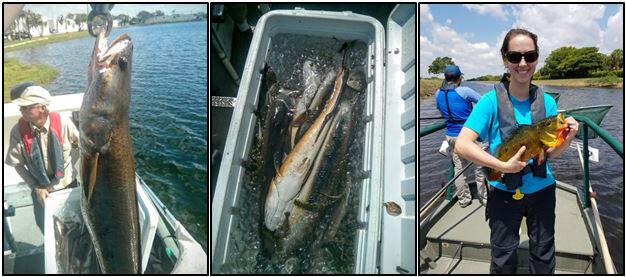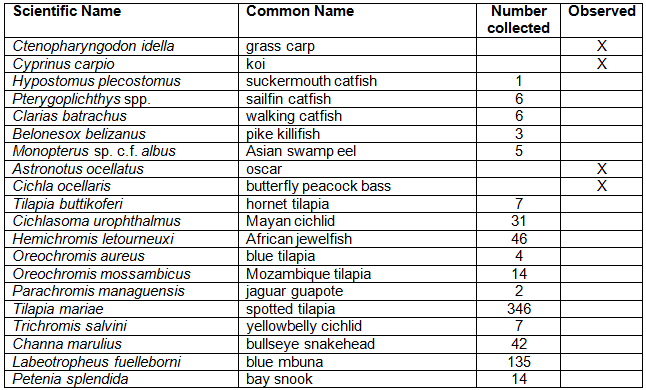May 23, 2016 – Five teams of fishery biologists from the U.S. Geological Survey (USGS), Florida Fish and Wildlife Conservation Commission (FWC), the National Park Service (NPS), Florida Museum of Natural History (FLMNH), University of Florida (UF), and Florida International University (FIU) sampled 12 sites for non-native fishes in Broward and Miami-Dade counties in southeastern Florida.

May 23, 2016 – Five teams of fishery biologists from the U.S. Geological Survey (USGS), Florida Fish and Wildlife Conservation Commission (FWC), the National Park Service (NPS), Florida Museum of Natural History (FLMNH), University of Florida (UF), and Florida International University (FIU) sampled 12 sites for non-native fishes in Broward and Miami-Dade counties in southeastern Florida. Gear used included electrofishing boats, backpack electrofisher, minnow traps, seines and dipnets.
The two electrofishing boat teams started in Tigertail Ponds where they collected bullseye snakehead (Channa marulius), which has recently invaded these ponds. Next, the teams surveyed the nearby C-11canal to check for potential range expansion of snakehead, but found none. While surveying the C-11 canal, a suckermouth catfish (Hypostomus) was collected. This is the first record for this species in the C-11 canal and thus a range extension.
One ground crew sampled Pinecrest Gardens to continue eradication efforts of the bay snook Petenia splendida. This effort built upon earlier work by FWC and the Everglades Cooperative Invasive Species Management Area (ECISMA) to eradicate the threat of this large, predatory cichlid before it is able to escape the gardens and spread through the adjacent canal system and into South Florida waters. The team also found a population of the African cichlid Labeotropheus fuelleborni.

A second ground crew sampled at Fuch’s Pond and recorded a range expansion for the yellowbelly cichlid Trichromis salvini. The final ground crew sampled the Homestead area to collect voucher specimens of Oreochromis and Pterygoplichthys. These species are particularly difficult to identify, and the museum vouchers will aid in assisting researchers to positively identify them in the future.
Twenty species of non-native fishes were collected or observed during the event. Forty-two lots containing 248 voucher specimens were deposited at the Florida Museum of Natural History.

All native species, along with two non-native species (grass carp Ctenopharyngodon idella and butterfly peacock bass Cichla ocellaris) were returned to the wild alive. All field observations of non-natives were entered into the USGS Nonindigenous Aquatic Species database (USGS 2016).
The participants of the May 2016 Fish Slam were Jesse Blanchard (FIU), Mary Brown (Cherokee Nations Technologies [CNT]), Matthew Cannister (CNT), Andre Daniels (USGS), Kelly Gestring (FWC), Howard Jelks (USGS) , Jeff Kline (NPS), Katie Lawson (UF), Mark Pepper (NPS), Kristen Reaver (CNT), Rob Robins (FLMNH), Pam Schofield (USGS), Jessica Schulte (CNT), Vanessa Trujillo (FIU), and Quenton Tuckett (UF).
Special thanks to Barron Moody of the Florida Fish and Wildlife Conservation Commission for assistance with permits for this sampling event. We thank Uwe Werner for permission to reproduce his photograph of bay snook. Amy Benson kindly read an earlier version of this webpage.
U.S. Geological Survey (USGS) (2016). Nonindigenous aquatic species database. U.S. Geological Survey, Gainesville, Florida. Available via http://nas.er.usgs.gov/. Accessed 13 June 2016
Below are other science projects associated with this project.
Fish Slam May 2023
Fish Chat and Slam December 2022
Southwest Florida Fish Slam – Spring 2022
Virtual Fish Slam - March 2021
Fish Chat and Slam November 2019
Treasure Coast and Central Florida Fish Slams - 2019
Fish Slam November 2018
Fish Slam - November 2017
Spring Fish Slam 2017 – Big Cypress
Florida Non-Native Fish Action Alliance
Fish Slam - Fall 2016
Impacts of Non-Native Fishes in the Florida Everglades
Below are news stories associated with this project.
Below are partners associated with this project.
May 23, 2016 – Five teams of fishery biologists from the U.S. Geological Survey (USGS), Florida Fish and Wildlife Conservation Commission (FWC), the National Park Service (NPS), Florida Museum of Natural History (FLMNH), University of Florida (UF), and Florida International University (FIU) sampled 12 sites for non-native fishes in Broward and Miami-Dade counties in southeastern Florida.

May 23, 2016 – Five teams of fishery biologists from the U.S. Geological Survey (USGS), Florida Fish and Wildlife Conservation Commission (FWC), the National Park Service (NPS), Florida Museum of Natural History (FLMNH), University of Florida (UF), and Florida International University (FIU) sampled 12 sites for non-native fishes in Broward and Miami-Dade counties in southeastern Florida. Gear used included electrofishing boats, backpack electrofisher, minnow traps, seines and dipnets.
The two electrofishing boat teams started in Tigertail Ponds where they collected bullseye snakehead (Channa marulius), which has recently invaded these ponds. Next, the teams surveyed the nearby C-11canal to check for potential range expansion of snakehead, but found none. While surveying the C-11 canal, a suckermouth catfish (Hypostomus) was collected. This is the first record for this species in the C-11 canal and thus a range extension.
One ground crew sampled Pinecrest Gardens to continue eradication efforts of the bay snook Petenia splendida. This effort built upon earlier work by FWC and the Everglades Cooperative Invasive Species Management Area (ECISMA) to eradicate the threat of this large, predatory cichlid before it is able to escape the gardens and spread through the adjacent canal system and into South Florida waters. The team also found a population of the African cichlid Labeotropheus fuelleborni.

A second ground crew sampled at Fuch’s Pond and recorded a range expansion for the yellowbelly cichlid Trichromis salvini. The final ground crew sampled the Homestead area to collect voucher specimens of Oreochromis and Pterygoplichthys. These species are particularly difficult to identify, and the museum vouchers will aid in assisting researchers to positively identify them in the future.
Twenty species of non-native fishes were collected or observed during the event. Forty-two lots containing 248 voucher specimens were deposited at the Florida Museum of Natural History.

All native species, along with two non-native species (grass carp Ctenopharyngodon idella and butterfly peacock bass Cichla ocellaris) were returned to the wild alive. All field observations of non-natives were entered into the USGS Nonindigenous Aquatic Species database (USGS 2016).
The participants of the May 2016 Fish Slam were Jesse Blanchard (FIU), Mary Brown (Cherokee Nations Technologies [CNT]), Matthew Cannister (CNT), Andre Daniels (USGS), Kelly Gestring (FWC), Howard Jelks (USGS) , Jeff Kline (NPS), Katie Lawson (UF), Mark Pepper (NPS), Kristen Reaver (CNT), Rob Robins (FLMNH), Pam Schofield (USGS), Jessica Schulte (CNT), Vanessa Trujillo (FIU), and Quenton Tuckett (UF).
Special thanks to Barron Moody of the Florida Fish and Wildlife Conservation Commission for assistance with permits for this sampling event. We thank Uwe Werner for permission to reproduce his photograph of bay snook. Amy Benson kindly read an earlier version of this webpage.
U.S. Geological Survey (USGS) (2016). Nonindigenous aquatic species database. U.S. Geological Survey, Gainesville, Florida. Available via http://nas.er.usgs.gov/. Accessed 13 June 2016
Below are other science projects associated with this project.
Fish Slam May 2023
Fish Chat and Slam December 2022
Southwest Florida Fish Slam – Spring 2022
Virtual Fish Slam - March 2021
Fish Chat and Slam November 2019
Treasure Coast and Central Florida Fish Slams - 2019
Fish Slam November 2018
Fish Slam - November 2017
Spring Fish Slam 2017 – Big Cypress
Florida Non-Native Fish Action Alliance
Fish Slam - Fall 2016
Impacts of Non-Native Fishes in the Florida Everglades
Below are news stories associated with this project.
Below are partners associated with this project.

























